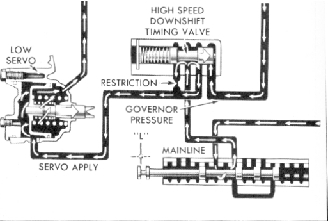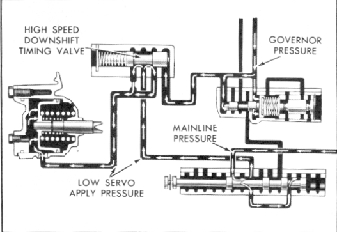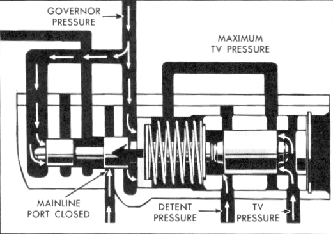


time for the high clutch to begin releasing and thus avoids a
severe shift or "lock-up" condition.
This downshift places the transmission in low gear, ready
for instant response and acceleration.
"To-Detent" Forced Downshift. At low moderate road
speeds, increased pressure on the accelerator can cause the TV
pressure to be regulated high enough to move the low-drive
shift valve to the left overcoming governor pressure. Throttle
valve pressure holds the shift valve in the low gear position
until car speed and resultant governor pressure causes an
upshift.
"Through-Detent" Forced Downshift. At all road speeds
below approximately 70 to 62 m.p.h. the transmission can be
automatically shifted to low range by depressing the accelera
tor linkage "throughdetent". This causes the production of
maximum TV pressure and moves the detent valve to open TV
pressure to the detent passage.
The resulting full TV pressure over-comes governor pres
sure acting on the shift valve. This action shifts the trans
mission to low gear as previously described (fig. 22PG). The
transmission will remain in low gear until either the accelerator
is released, or the car speed reaches the maximum upshift
point (68-74 mph).
At road speeds above approximately 63 m.p.h., governor
pressure acting on the shift valve is high enough to prevent TV
pressure from moving the shift valve. Therefore, regardless of
accelerator position, the transmission will remain in high gear
at all road speeds above approximately 70 m.p.h.
Fig. 23PG-High Speed Downshift Timing Valve
At these low speeds the valve is held to the right, and does
not offer any resistance to low servo apply (fig. 23PG). As
road speed increases, the higher governor pressure acts on the
right end of the valve until, at approximately 30 m.p.h., the
valve is moved to the left. This movement blocks the non
restricted part, routing the servo apply oil through the re
stricted orifice. This restriction of flow causes the band apply
to be delayed slightly and is thus timed to the high clutch
High Speed Downshift
Timing Valve
The high speed downshift timing valve is a spring loaded
spool valve located in the main control body. The function of
this valve is to control the low servo apply pressure at high
road speeds. The actions of this valve are affected by spring
pressure on the left end and governor pressure on the right. At
low speeds, 30 m.p.h. or less (lower governor pressure), the
valve is held to the right by spring pressure. In this position,
the valve offers two paths of flow for the low servo apply
pressure. The passage on the right offers a non-restricted path
while the one on the left includes a restricted orifice.
Manual Low Circuit
When the manual valve is moved to the "L" position,
mainline pressure is delivered to the low servo apply circuit
and to the vacuum modulator exhaust, but cannot enter the
high clutch apply circuit (fig. 24PG). Since the high clutch
apply is not subjected to mainline pressure, the position of the
shift valve doesn't affect the transmission, and it will remain in
low gear regardless of road speed.
CAUTION: Because of this positive locked-in-low feature,
the driver must not exceed the normal maximum shift
point speed. See shift point chart in the appropriate
Chassis Service Manual.
Fig. 22PG-Through Detent Forced Downshift
Fig. 24PG-Manual Low Circuit
